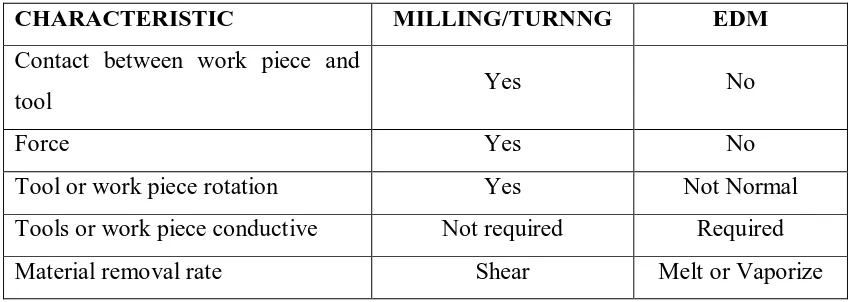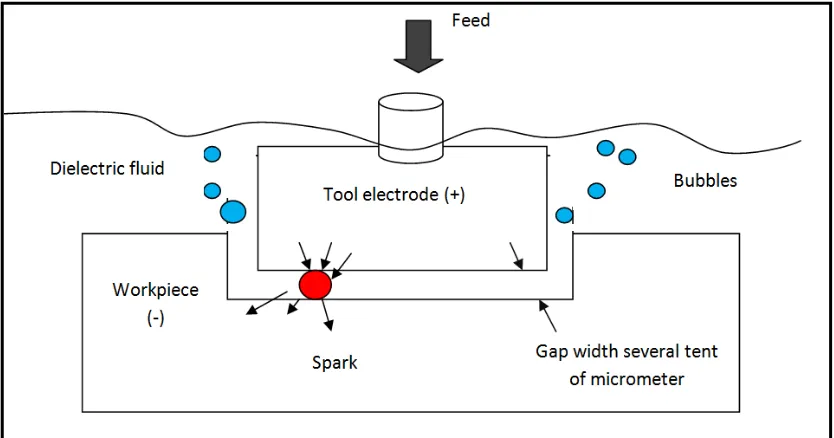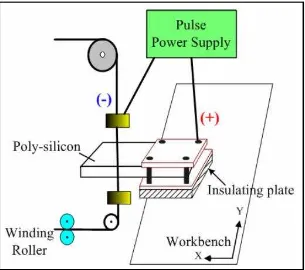UNIVERSITI TEKNIKAL MALAYSIA MELAKA
EXPERIMENTAL INVESTIGATION OF STAINLESS STEEL BY
USING ELECTRICAL DISCHARGE MACHINE (EDM)
This report submitted in accordance with requirement of the Universiti Teknikal Malaysia Melaka (UTeM) for the Bachelor Degree of Manufacturing Engineering
(Manufacturing Process)(Hons.)
by
NUR RASHIDAH BINTI MOHMAD DAUD BO51110098
890507-23-5122
UNIVERSITI TEKNIKAL MALAYSIA MELAKA
BORANG PENGESAHAN STATUS LAPORAN PROJEK SARJANA MUDA
TAJUK: EXPERIMENTAL INVESTIGATION OF STAINLESS STEEL BY USING
ELECTRICAL DISCHARGE MACHINE (EDM)
SESI PENGAJIAN: 2013/14 Semester 2
Saya NUR RASHIDAH BINTI MOHMAD DAUD
Mengaku membenarkan Laporan PSM ini disimpan di Perpustakaan Universiti Teknikal Malaysia Melaka (UTeM) dengansyarat-syarat kegunaan seperti berikut: 1. Laporan PSM adalah hak milik Universiti Teknikal Malaysia Melaka dan penulis. 2. Perpustakaan Universiti Teknikal Malaysia Melaka dibenarkan membuat salinan
untuk tujuan pengajian sahaja dengan izin penulis.
DECLARATION
I hereby, declared this report entitled “Experimental Investigation of Stainless Steel by using Electrical Discharge Machine (EDM)” is the results of my own research except as cited in references
Signature : ……….
Author’s Name : NUR RASHIDAH BINTI MOHMAD DAUD
APPROVAL
This report is submitted to the Faculty of Manufacturing Engineering of UTeM as a partial fulfillment of the requirements for the degree of Bachelor of Manufacturing Engineering (Manufacturing Process) (Hons.). The member of the supervisory is as follow:
ABSTRAK
Electrical Discharge Machining (EDM) adalah salah satu proses pemesinan termaju, berdasarkan termo tenaga elektrik di antara bahan kerja dan elektrod. Biasanya, EDM digunakan untuk memesin bahan yang mempunyai kekerasan yang tinggi dan bentuk yang kompleks. Dalam kajian ini, kesan saiz mikro dan nano bagi serbuk karbon yang ditambah kedalam bendalir dielektrik pada keluli tahan karat telah disiasat dengan menggunakan proses EDM. Dalam eksperimen ini, SODICK AQ35L adalah model mesin EDM yang digunakan untuk memesin bahan keluli tahan karat dengan menggunakan elektrod tembaga. Berat bahan kerja dan elektrod telah direkodkan sebelum dan selepas eksperimen dengan menggunakan
Precise Digital Balance untuk mendapatkan material removal rate (MRR) dan tool wear rate
ABSTRACT
DEDICATION
First and foremost, I would like to express my grea test appreciation to Universiti Teknikal Malaysia Melaka for giving me the opportunity to undergo my final year “Projek Sarjana
Muda”. A special thank you also goes to my supervisor Dr. Liew Pay Jun for her dedication and guidance during the period of undergoing my project and also to technician En Hanafiah for his guidance. Last but not least, I want to thank my mom and dad for their support as well as to all my friends Fazreena Binti Mohamad Noor Adami and Muhammad Nur Syafiq bin
abdul Rahman who never give up encouraging me to complete this report.
ACKNOWLEDGEMENT
Firstly, I am thankful to ALLAH S.W.T for blessing me in finishing this final year project (FYP) with successful complete and in achieving the objectives of this project. Hopefully, this project will be benefit to all.
In this opportunity, I would like to give my sincere gratitude to my family, Mohmad Daud bin masro, my father, Masriah binti Abu, my mother and all of family members for morale support, motivation and encouragement in completing this final year project and in finishing my study in UTeM with successful
I also would like to convey my full appreciation and thankful to my supervisor, Dr Liew Pay Jun for her guidance, supervising, and continuous support to complete my final year project for these two semesters. She has been very helpful and always advices me whenever there are problem in complete this project. I really appreciate every advice and without her support, critics I could not finish this thesis as presented here.
My sincere thanks go to vocational advisor, Mr Hanafiah for his guidance for in operating the Electrical Discharge Machine.
TABLE OF CONTENT
List of Abbreviation, Symbols and Nomencatures xi
CHAPTER 1 : INTRODUCTION
2.1 Electrical Discharge Machine (EDM) 4
2.1.1 History of EDM 6
2.1.2 Types of EDM 7
2.1.2.1 Wire Electrical Discharge Machining (WEDM)
7
2.1.2.2 EDM die-sinking 8
2.2 Principle of EDM die-sinking 9
2.4 EDM characteristic 13
2.4.1 Material Removal Rate (MRR) 14
2.4.2 Tool Wear Rate (TWR) 15
2.9 Powder mixed electrical discharge machining 22
CHAPTER 3 : METHODOLOGY
3.1 Planning project 26
3.2 Specimen preparation 29
3.3 Tool preparation 30
3.4 Carbon powder 31
3.5 Machines and Measurements Equipments 32
3.5.1 EDM Die-Sinker machine 32
3.5.2 Ultrasonic 33
3.5.3 Precision digital balance 34
3.5.4 Surface roughness measurement 34
3.5.5 Stereo microscope 35
3.6 Experimental Conditions 36
CHAPTER 4 : RESULT & DISCUSSION
4.1 Result and analysis of the experiment 37
4.1.1 Material removal rate (MRR) 37
4.1.2 Tool wear rate (TWR) 40
4.1.3 Spark gap 43
CHAPTER 5 : CONCLUSION AND FUTURE WORK
5.1 CONCLUSION 49
5.2 FUTURE WORK 50
REFERENCE
51LIST OF TABLE
2.1 Comparison between EDM process and conventional machining processes (milling/turning)
5
2.2 Electrode Polarities for Different Workpiece Materials 13
3.1 Material properties of stainless steel 29
3.2: Material properties of copper electrode 30
3.3 Concentration of carbon powder mixture 33
3.6 Experimental condition 36
4.1 Data of material removal rate (MRR) 38
4.2 Data of tool wear rate (TWR) 41
4.3 Data of spark gap 44
LIST OF FIGURE
2.1 EDM process 6
2.2 Schematic diagram of WEDM 8
2.3 Schematic diagram of EDM Die-Sinker Set-up 9
2.4 Working principle of EDM 9
2.5 Principle of EDM process 10
2.6 Pulse wave form of pulse generator 12
2.7 Different layers on EDM Surface 16
2.8 EDM surface layer for W300 ferritic steel material 17
2.9 The arimethic mean value 17
2.10 Schematic diagram of EDM for spark gap 18
2.11 Difference between electrode (Cu ZrB2 material) (a) after and (b) before machining using EDM Die Sinking
20
2.12 Principle of powder mixed EDM 23
2.13 Micrographs of the cross section of craters for (a) kerosene and (b) kerosene and nickel powder mixed fluid, NPMF
24
2.14 Generation mechanism of TiC layer 24
2.15 carbon nanotubes (CNT) have a straight-pin shape 25
3.1 Flow chart of methodology for chapter 1, 2, and 3 17 3.2 Flow chart of methodology for chapter 4 and 5 18
3.3 Stainless Steel Material 29
3.4 Dimension of specimen 30
3.5 Copper electrode 31
3.6 Dimension of electrode 31
3.7 Sodick AQ35L series EDM die-sinking machine 32
3.8 Sartorius Stedim (LABSONIC® P) series Ultrasonic 33
3.9 Precise Digital Balance 34
3.10 Surface roughness tester Mitutoyo SJ-301 35
4.1 Effect of the different nano and micro particles size on material removal rate (MRR)
39
4.2 Effects of micro and nano sizes of carbon powder addition into the dielectric fluid on tool wear rate (TWR)
42
4.3 Effects of micro and nano sizes of carbon powder addition into the dielectric fluid on spark gap
45
4.4 Effects of micro and nano sizes of carbon powder addition into the dielectric fluid on surface roughness
LIST OF ABBREVIATIONS, SYMBOLS AND
NOMENCLATURE
EDM - Electrical Discharge Machining WEDM - Wire Electrical Discharge Machining
CNC - Computer Numerical Controlled
BeCu - Beryllium Copper
- Material weight before machining - Material weight after machining tm - Machining time
- Tool (electrode) Weight before machining - Tool (electrode) Weight after machining n - Number of readings
Ton - Pulse on time Toff - Pulse off time μsec - Micro second
μm - Micrometer
g/min - Gram per minute mm - Millimeter g/l - Gram per liter % - Percentage
This chapter describes the introduction of the experiment. In this experiment, the effect of micro and nano size of carbon powder as an additive into dielectric fluid were compared by using Electrical Discharge Machining (EDM). This chapter includes the background, problem statement, objective and scope of this study.
1.1 Background
Electrical Discharge Machine (EDM) is most important acknowledge technologies in manufacturing industries since many complex shapes can be machining by using a simple shaped of the tool electrode. Electrical Discharge Machining (EDM) is an advance manufacturing process. This process used to remove the material by controlled erosion from a series of electric sparks between an electrode and workpiece with the existence of dielectric fluid. The electrode may be considered as the cutting tool (Nikhil et al, 2012). Currently, EDM is an extensive technique used in the industry for machine electrically conductive and difficult materials for manufacturing of mould, die, automotive, aerospace and surgical components. (Soumyakant et al, 2012).
The latest developments in the field of EDM have progressed due to the growing application of EDM process. other than that, the challenges being faced in the modern manufacturing industries, from the development of new materials that are hard and difficult to machine such as tool steels, composites, ceramics, stainless steels, super alloys, carbides, heat resistant steel and other being widely used in die
and mould making industries need the high precision, complex shapes and high surface finish (Ayush, 2012).
The material used in this experiment is stainless steel due to its widely used in industrial applications. It has excellent material properties primarily by their corrosion resistance, high strength and ductility (Sidda et al, 2010). At the present, applications of stainless steel are widespread in industries such as food processing equipment, cryogenic vessels, gutters, brewing equipment, downspout and flushing and components for chemical environment.
Additive powder into dielectric fluid is one of the new innovations in EDM process. According Ahsan et al. (2012), when the powder additive into dielectric fluid, charge powder are speeded up by the electric field and act as conductors and powder gather in clusters. The chain formation by interlocking which help to form bridging networks between workpiece and tool which caused early explosion or spark. The good electrical conductivity of powder helps to increase the discharge gap between the workpiece and tool and can be increase the insulating strength of the electric fluid and also improved EDM machibility (Soumyakant et al, 2012). In this situation may be occur multiple discharges, it can lead to reduce of the crater size on the surface of workpiece. In turn, might be obtain a better surface finish compare than without powder additive powder into dielectric fluid (Liew et al, 2013).
1.2 Problem statement
1.3 Objective
The objectives of this project are:
1 To compare the effect of micro and nano powders additive by using conventional electrical discharge machine.
2 To investigate the effect of carbon powder concentration on material removal rate (MRR), tool wear rate (TWR), surface roughness and spark gap of stainless steel by using EDM.
1.4 Scope of Project
Basically, literature review is one of the scope studies. Literature review serves as a guide to conduct this analysis. It will provide a variety of information about the electrical discharge machine. In addition, it also provides information to conduct all operations. Various references have been made in this literature review, which are research journals, books, conference online or printed article.
2.1 Electrical Discharge Machine (EDM)
Electrical discharge machining (EDM) is an advance manufacturing processes. EDM used most widely and successfully applied in manufacture geometrically the complex or process in fact to manufacture hard metals or those that would be very difficult in the machine with traditional techniques (Ojha et al, 2010, Soumyakant et al, 2012 and Sidda et al, 2010).
Mustafa et al. (2011) proved the EDM process also can be compared with other conventional machining processes like milling and turning as shown in Table 2.1. This comparison performed in terms of contact between workpiece and cutting tool, force, tool or workpiece rotation, tool or workpiece conductive and material removal method. EDM is the fourth most popular machining method at present, which is milling, turning, grinding, and drilling.
Table 2.1: Comparison between EDM process and conventional machining processes
Tool or work piece rotation Yes Not Normal
Tools or work piece conductive Not required Required
Material removal rate Shear Melt or Vaporize
Electrical discharge machining (EDM) is an advance manufacturing processes. EDM used most widely applied in manufacture geometrically the complex or process in fact to manufacture hard metals or those that would be very difficult in the machine with traditional techniques (Ojha et al, 2010, Soumyakant et al, 2012 and Sidda et al, 2010).
Figure 2.1: EDM process (Mahendran et al, 2010)
However, EDM has been replacing the traditional machining operations like milling, drilling, and other operations. Currently, EDM machining being a selection throughout the world in manufacturing industries. EDM is can do to machining geometrically complex or hard material components, high accuracy and difficult to machine such as heat resistant steels, composites, super alloys, ceramics, heat treated tool steels, carbides, heat resistant steels and others. According to Shailesh (2010), EDM was being used in application of die and mold, nuclear industries, aerospace, medical and surgical, aeronautics, sports, instruments, optical and others application.
2.1.1 History of EDM
The history of EDM machining techniques discovered in early 1770s when it was
discovered by an English Scientist is Joseph Priestly and found the erosive effect of
electrical discharges or sparks. However, this technique is used but has some
problems which is EDM Machining was very not accuracy and riddled with failures
(Shailesh, 2010).
While in the 1949 at the Moscow University, be found two Russian scientists are Dr.
for difficult metals to machining by vaporizing material from the surface of metal. Then in the 1950’s research about resistance capacitance type of power supply at EDM system.
According to Shailesh (2010), at mid 1970s, commercially developed Wire EDM is
one of the techniques being selection in the industry to helped shape the metal
working industry. At 1980's a computer numerical controlled (CNC) EDM was
introduced in USA. Other than that many research have be done to improve in many
aspect such as improve the quality on surface, material removal rate by using
different cutting tool or parameters, improvement the spark gap by using different
dielectric fluid and other research (Ho et al, 2003 and Pawade et al, 2013).
2.1.2 Types of EDM
There are two main types of EDM, which are Wire Electrical Discharge Machining (WEDM) and EDM die-sinking. Both of them are very suitable for applications in automotive stamping dies, tools, medical component and body aircraft components. This is caused by both of them can produce small size and high accuracy part well as large items.
2.1.2.1 Wire Electrical Discharge Machining (WEDM)
WEDM is referring to wire electrical discharge machining. The WEDM used for complex shapes, which have sharp edges that are very difficult to machining processes. WEDM also used for high precision machining of all types of conductive materials. The suitable material in the WEDM process is metals, metallic alloys, graphite, or even some ceramic materials and other of any hardness.
programming a path for the wire to travel along sort of like a super precision bandsaw. The diameter wire range from 0.0120 to 0.0008 inches (Singh et al, 2009 and Bo et al, 2009).
Figure 2.2: Schematic diagram of WEDM (Bo et al, 2009)
2.1.2.2 EDM die-sinking
The EDM die sinking is shown in Figure 2.3. According to Soumyakant et al.
(2012), EDM die-sinking processes also know as nontraditional process where the
tool does not contacts the workpiece. It is also refers to spark machining, spark
eroding, burning, is a manufacturing process to make the profile shape of workpiece
is obtain using electrical discharge. The material removal from the workpiece occurs
by a series of rapidly repeated discharge between electrode and workpiece, separated


